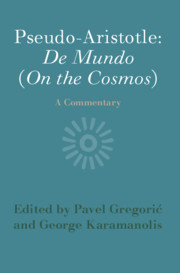Book contents
- Pseudo-Aristotle: De mundo (On the Cosmos)
- Pseudo-Aristotle: De mundo (On the Cosmos)
- Copyright page
- Contents
- Figures
- Contributors
- Preface
- Abbreviations
- Chapter 1 Introduction
- Chapter 2 On Philosophy and Its Proper Subject (Chapter 1)
- Chapter 3 The Heavenly Sphere (Chapter 2, 391b9–392a31)
- Chapter 4 The Sublunary Domain (Chapters 2–3, 392a31–393a8)
- Chapter 5 Geography (Chapter 3, 393a9–394a6)
- Chapter 6 Meteorology (Chapter 4)
- Chapter 7 The Eternity of the Cosmos (Chapter 5)
- Chapter 8 God’s Relation to the Cosmos (Chapter 6)
- Chapter 9 God’s Many Names (Chapter 7)
- Bibliography
- Index
Chapter 3 - The Heavenly Sphere (Chapter 2, 391b9–392a31)
Published online by Cambridge University Press: 10 December 2020
- Pseudo-Aristotle: De mundo (On the Cosmos)
- Pseudo-Aristotle: De mundo (On the Cosmos)
- Copyright page
- Contents
- Figures
- Contributors
- Preface
- Abbreviations
- Chapter 1 Introduction
- Chapter 2 On Philosophy and Its Proper Subject (Chapter 1)
- Chapter 3 The Heavenly Sphere (Chapter 2, 391b9–392a31)
- Chapter 4 The Sublunary Domain (Chapters 2–3, 392a31–393a8)
- Chapter 5 Geography (Chapter 3, 393a9–394a6)
- Chapter 6 Meteorology (Chapter 4)
- Chapter 7 The Eternity of the Cosmos (Chapter 5)
- Chapter 8 God’s Relation to the Cosmos (Chapter 6)
- Chapter 9 God’s Many Names (Chapter 7)
- Bibliography
- Index
Summary
This part of Chapter 2 offers two definitions of ‘cosmos’ and then describes the latter as a whole containing the largest stable structures composed of the five elements: aether, fire, air, water and earth. It explains the division of the cosmos into the upper or supralunary part, which is made of aether and where things are incorruptible and in regular circular motion, and the lower or sublunary part, where things are diverse and less regular, composed of the remaining four elements, and subject to constant generation and corruption. The perfect supralunary part forms a system of concentric rotating spheres. While the fixed stars all move ‘on one visible surface of the whole of the heavens’, where they keep their position, the planets are simply said to each move in their own orbit, with no explicit mention of the higher number of moving spheres posited by Eudoxus or Callippus. Below the lowest planetary sphere, that of the Moon, the sublunary part of the cosmos begins. It is also organised in concentric spheres, each one dominated by one of the four elements, starting with fire and ending with earth in the immobile centre of the universe. The author pays special attention to the immutable aether that belongs to the causal chain extending from God to all the motions in the earthly region of the universe. In virtue of its physical perfection, the ether is indispensable for God’s guidance and administration of all heaven and Earth.
- Type
- Chapter
- Information
- Pseudo-Aristotle: De Mundo (On the Cosmos)A Commentary, pp. 33 - 61Publisher: Cambridge University PressPrint publication year: 2020
- 1
- Cited by



